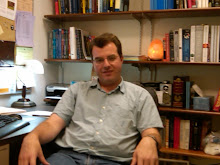I don't have time to write up my full thoughts on chapter 2; a lot of the themes seem to be repeated in what little I've read of the next chapter, so I think I'll just respond to those themes after I've read the whole book. But a few quick thoughts:
1) The student in the second chapter took a physics class. Some of the things that he reports are valid criticisms of how we teach physics. I think we've actually made progress on a subset of them (remember, this book is more than 20 years old), but we could stand to make more progress.
2) Some of his critiques go to points that sound nice on the surface, but they would not work as well as he thinks if we actually tried to do it at scale with the students that we get. The student does note that we actually do some things right, that our students do get motivated in certain ways that many humanities students don't (in his observation). Of course, we also fail to motivate in certain ways that the humanities do more effectively.
It's tempting to say "Well, obviously just take the best of each!" but that implies that upsides and downsides are completely separable. I don't think real life works that way.
3) I'm not going to name names, but in addition to the observations of the student, the author frequently cites (positively) the observations of someone whom I've interacted with. I was...not impressed. To put it mildly. That colors my reading.
4) One thing that outside critics of physics often miss is that we'd love to spend more time on the Big Picture but we have a hard, cumulative, technical task in front of us. There's no evading that. We can talk about Big Ideas all day, but the real progress on those ideas was only made through painstaking technical work. On the margin, we could (and probably should) spend a bit more time than we do on Big Ideas rather than technical calculation, but those technical skills are vital to either using physics or making progress on advancing the field of physics, and they take a lot of time to hone. I'm open to providing more complementary/supplementary treatment of Big Ideas, but if students don't get a whole lot of practice on the hard, technical side of the field then we are cheating them out of the opportunity to have a career where they either use physics or make advances in physics.
5) Frankly, a lot of the "I am more, like, into the Big Ideas, man!" types are dilettantes, and usually white dude dilettantes. Sorry, but it's true. Yes, yes, there are flaky women and flaky people of color; I recognize and support the right of people of diverse identities to be flakes. Still, the flaky "I'm, like, more into, like, the ideas than, you know, the math, because my mind is more about being weird and flexible and seeing the Real Ideas, you know?" types are disproportionately white dudes. That's my in-the-trenches observation. I try to avoid stereotyping but this one is born out by observation.
That's not to say that everyone who wants to talk about Big Ideas is a flake, but the flakes ALWAYS say that. Always.
Why am I commenting on it? Because everyone agrees that physics needs to diversify, so I find it hilarious that our critics then come at us with something that the dilettante white dudes have been saying to us since forever. Believe me, you don't want us designing curricula around those guys if you want us to attract women and people of color.
6) That said, there are curricula that do more to address Big Ideas while also developing technical skills. Moore's Six Ideas That Shaped Physics and also the Matter and Interactions curriculum are both excellent examples of that. We need to do more of that.
7) While I can and will weigh the pros and cons of the critics in more detail, it is very much a marker of when the book was written that she couches the critiques in terms of "Maybe if we addressed this we could solve the STEM shortage..." I am listening to Sublime as I type this. The 90's were good times, man. Good times.
Friday, November 4, 2016
Tobias, Chapter 2
Subscribe to:
Post Comments (Atom)



No comments:
Post a Comment